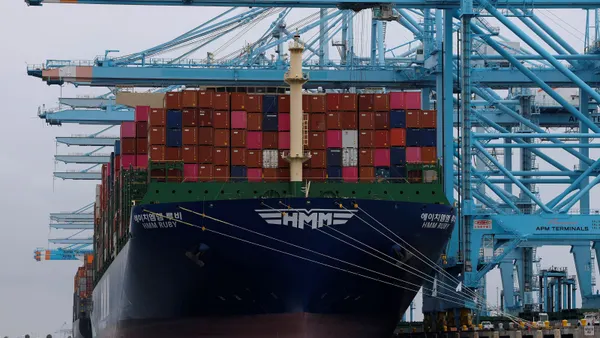Dive Brief:
- Shipment volumes for March dropped 9.2% year over year (YoY), according to the Cass Freight Index, but improved for the second straight month, the company said in a report Monday. "April will undoubtedly be worse and likely the worst month in a long time," wrote the report's author, David Ross, managing director of global transportation and logistics at Stifel. He said April volumes should rival those of early 2009.
- Freight expenditures for March fell by 8.2% YoY and by 1% month over month (MoM). The report said Cass expects transport pricing to stay low through May, "but we're watching capacity exits and a potential re-stocking event to drive rates higher again later this year," Ross wrote.
- Cass expects market volatility to continue for weeks to come. There's no chance for YoY growth in domestic shipments and freight costs in the second quarter, showing that the coronavirus pandemic quickly widened from a production concern in China to a global consumer spending problem, Ross wrote.
Dive Insight:
The gap between the number of trucks and loads is closing, according to DAT, and so is the gap between shipping volume and rates, Cass data shows. Because social distancing has put normal buying habits on hold, neither the shipper nor the carrier is guaranteed an easier time.
"No business, no jobs, and no income for many leads to much less freight moving around," Ross wrote. "There has been a clear divide between winners and losers of these shut-in orders with demand for groceries, home improvement, e-commerce, and consumer staples increasing, while restaurant, auto, and (mall) retail falling to practically zero volume."
Jarring unemployment rates make it difficult to forecast demand, the report noted. Cass typically tracks inventory levels to help with demand forecasting, but the volatility of the market makes the latest data out-of-date.
"Some shippers have inventory filling up warehouses, others have it sitting in ocean containers not even being unloaded, and still others have near empty warehouses, because they can't keep any inventory due to the high demand that causes freight to flow through the system as soon as it's produced. Coming out of the period, some will need to restock, and some will need to destock. Where that balances out is hard to tell," Ross wrote.
For trucking, how a carrier is fairing depends on what it hauls. Those transporting essential and high-demand supplies are moving, while others are left to monitor loadboards. Cass showed linehaul rates declined 6.6% YoY in March, the lowest rate since June 2009. "This broad pricing pressure should last a little longer, but then when the economy re-opens (and it will), we'll see how many truckers are left and how much freight needs to be moved," Ross wrote.
When it comes to ocean shipping, the drop in demand shifted from China to Europe late last month. Carriers announced more blank sailings as a result. A reduction in imports at U.S. ports translates to less container volume for intermodal businesses.
"While shipment volumes should trough in April due to the coronavirus crisis," Ross wrote of rail, "we expect a rebound in weekly volumes later in 2Q20 to signal a climb back toward more normal economic activity."
U.S. railroads originated 899,673 carloads last month, down 6% in March, YoY, according to the Association of American Railroads. They originated 935,380 containers and trailers, down 12.2% YoY. Carloads and containers dropped MoM.
Ross also noted the at-capacity airfrieght market, in part due to lack of belly space in commercial flights. "Although some passenger carriers are literally placing cargo in the main cabin around seats and not just below deck to try and earn some money from their assets that would otherwise be grounded," Ross wrote. Airfreight volume fell for the 15th straight month in February, and freight capacity contracted for the first time since 2017, numbers from the International Air Transport Association showed.











